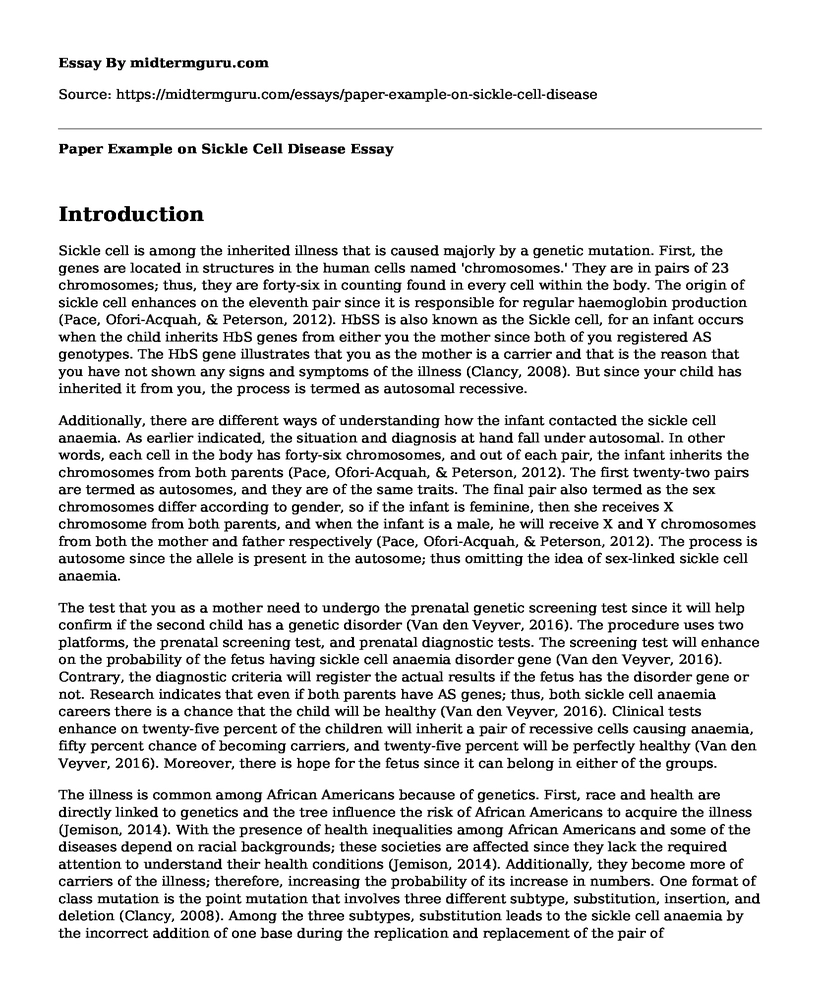Introduction
Sickle cell is among the inherited illness that is caused majorly by a genetic mutation. First, the genes are located in structures in the human cells named 'chromosomes.' They are in pairs of 23 chromosomes; thus, they are forty-six in counting found in every cell within the body. The origin of sickle cell enhances on the eleventh pair since it is responsible for regular haemoglobin production (Pace, Ofori-Acquah, & Peterson, 2012). HbSS is also known as the Sickle cell, for an infant occurs when the child inherits HbS genes from either you the mother since both of you registered AS genotypes. The HbS gene illustrates that you as the mother is a carrier and that is the reason that you have not shown any signs and symptoms of the illness (Clancy, 2008). But since your child has inherited it from you, the process is termed as autosomal recessive.
Additionally, there are different ways of understanding how the infant contacted the sickle cell anaemia. As earlier indicated, the situation and diagnosis at hand fall under autosomal. In other words, each cell in the body has forty-six chromosomes, and out of each pair, the infant inherits the chromosomes from both parents (Pace, Ofori-Acquah, & Peterson, 2012). The first twenty-two pairs are termed as autosomes, and they are of the same traits. The final pair also termed as the sex chromosomes differ according to gender, so if the infant is feminine, then she receives X chromosome from both parents, and when the infant is a male, he will receive X and Y chromosomes from both the mother and father respectively (Pace, Ofori-Acquah, & Peterson, 2012). The process is autosome since the allele is present in the autosome; thus omitting the idea of sex-linked sickle cell anaemia.
The test that you as a mother need to undergo the prenatal genetic screening test since it will help confirm if the second child has a genetic disorder (Van den Veyver, 2016). The procedure uses two platforms, the prenatal screening test, and prenatal diagnostic tests. The screening test will enhance on the probability of the fetus having sickle cell anaemia disorder gene (Van den Veyver, 2016). Contrary, the diagnostic criteria will register the actual results if the fetus has the disorder gene or not. Research indicates that even if both parents have AS genes; thus, both sickle cell anaemia careers there is a chance that the child will be healthy (Van den Veyver, 2016). Clinical tests enhance on twenty-five percent of the children will inherit a pair of recessive cells causing anaemia, fifty percent chance of becoming carriers, and twenty-five percent will be perfectly healthy (Van den Veyver, 2016). Moreover, there is hope for the fetus since it can belong in either of the groups.
The illness is common among African Americans because of genetics. First, race and health are directly linked to genetics and the tree influence the risk of African Americans to acquire the illness (Jemison, 2014). With the presence of health inequalities among African Americans and some of the diseases depend on racial backgrounds; these societies are affected since they lack the required attention to understand their health conditions (Jemison, 2014). Additionally, they become more of carriers of the illness; therefore, increasing the probability of its increase in numbers. One format of class mutation is the point mutation that involves three different subtype, substitution, insertion, and deletion (Clancy, 2008). Among the three subtypes, substitution leads to the sickle cell anaemia by the incorrect addition of one base during the replication and replacement of the pair of chromosomes in the place of the complementary composition (Clancy, 2008).
References
Clancy, S. (2008). Genetic Mutation. Retrieved October 29, 2018, from The Nature Commercial Website: https://www.nature.com/scitable/topicpage/genetic-mutation-441
Jemison, D. (2014, July 8). Sickle Cell Anemia amongst African American. Retrieved October 29, 2018, from The Michigan State University Education Website: http://anthropology.msu.edu/anp204-us14/2014/07/08/sickle-cell-anemia-amongst-african-american/
Pace, B., Ofori-Acquah, S., & Peterson, K. (2012). Sickle Cell Disease: Genetics, Cellular and Molecular Mechanisms, and Therapies. Hindawi Publishing Corporation, 1-2 doi:10.1155/2012/143594.
Van den Veyver, I. B. (2016). Recent advances in prenatal genetic screening andtesting. F1000Research, 5.
Cite this page
Paper Example on Sickle Cell Disease. (2022, Aug 29). Retrieved from https://midtermguru.com/essays/paper-example-on-sickle-cell-disease
If you are the original author of this essay and no longer wish to have it published on the midtermguru.com website, please click below to request its removal:
- Health Information Technology and Electronic Medical Record
- Distinct Characteristics of Nursing - Paper Example
- Benchmarking Healthcare Policy Analysis: Affordable Care Act
- Paper Example on Opioid Abuse Disorder: Symptoms, Diagnosis and Treatment
- Approach to Cancer Care - Paper Example
- Pernicious Anemia: Causes, Symptoms, & Treatments - Research Paper
- Smile Matters: Dental Appearance and Physical Perception - Essay Sample







